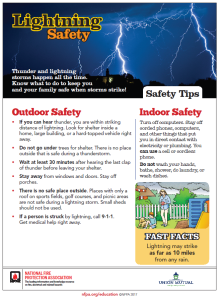June 19-25 is Lightning Safety Week
June 19-25, 2022 is National Lighting Safety Week – created in 2001 to draw attention to the deadly power of lightning. According to weather.gov, this increased awareness has led to a reduction in fatalities over the last 20-plus years. Summer storms and other unsteady weather patterns can turn a nice day into a nightmare in a hurry. It’s prudent to have a lightning plan in the back of your mind when planning any outdoor activity, and pay attention to changing conditions.
Lightning is also a cause of property damage, resulting in power surges, structure fires and wildfires. Here are 3 ways to protect your property during thunder and lightning storms from our friends at the National Fire Protection Association (NFPA).
Personal Lightning Safety Tips
- PLAN in advance your evacuation and safety measures. When you first see lightning or hear thunder, activate your emergency plan. Now is the time to go to a building or a vehicle. Lightning often precedes rain, so don’t wait for the rain to begin before suspending activities.
- IF OUTDOORS…Avoid water. Avoid the high ground. Avoid open spaces. Avoid all metal objects including electric wires, fences, machinery, motors, power tools, etc. Unsafe places include underneath canopies, small picnic or rain shelters, or near trees. Where possible, find shelter in a substantial building or in a fully enclosed metal vehicle such as a car, truck or a van with the windows completely shut. If lightning is striking nearby when you are outside, you should:
- Crouch down. Put feet together. Place hands over ears to minimize hearing damage from thunder.
- Avoid proximity (minimum of 15 ft.) to other people.
- IF INDOORS… Avoid water. Stay away from doors and windows. Do not use the telephone. Take off head sets. Turn off, unplug, and stay away from appliances, computers, power tools, & TV sets. Lightning may strike exterior electric and phone lines, inducing shocks to inside equipment.
- SUSPEND ACTIVITIES for 30 minutes after the last observed lightning or thunder.
- INJURED PERSONS do not carry an electrical charge and can be handled safely. Apply First Aid procedures to a lightning victim if you are qualified to do so. Call 911 or send for help immediately.
- KNOW YOUR EMERGENCY TELEPHONE NUMBERS.
Check out this great video from the National Weather Service for more tips:




